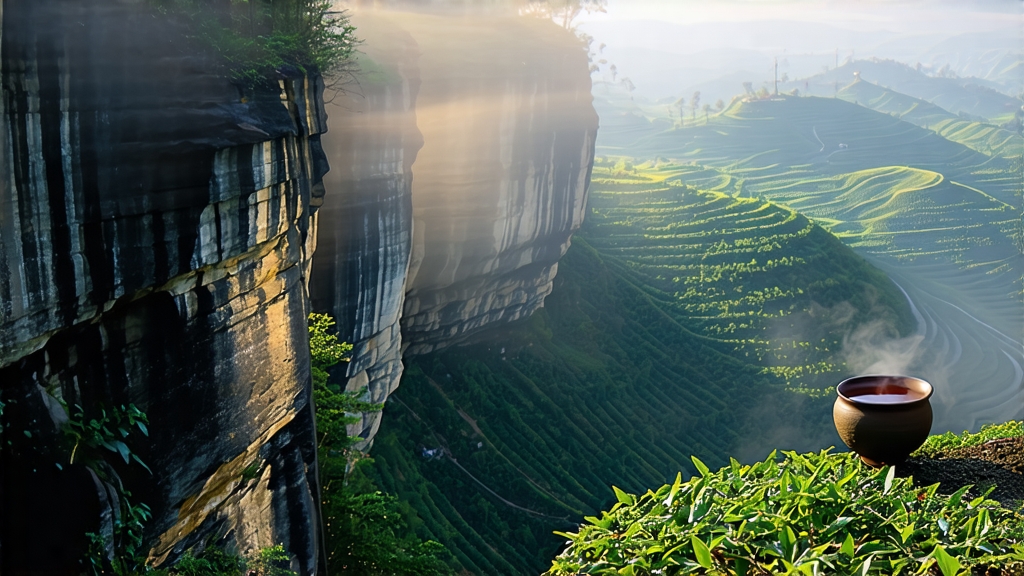
High above the winding Jiuqu Stream, where the Wuyi Mountains rise like stone pillars cloaked in perpetual mist, grows the most storied oolong on earth—Da Hong Pao, literally “Big Red Robe.” To Chinese tea lovers the name alone evokes reverence, conjuring images of crimson-robed monks, imperial seals, and granite crevices so steep that monkeys were once trained to pluck the leaves. For the international drinker still navigating the vast galaxy of Chinese tea, Da Hong Pao offers the perfect portal into the rock-ribbed soul of Minbei oolong: a liquor that tastes of roasted apricot, limestone, and orchid, and a history that blurs the line between myth and meteorology.
Legend sets the origin in the early Ming dynasty. A passing scholar, overcome by fever on his way to the capital, was revived by a brew made from the bushes clinging to Tianxin Rock. Upon winning the top jinshi degree, he returned in crimson official robes to drape the bushes in gratitude—hence the name. Another tale speaks of a Ming empress whose incurable illness was soothed by the same tea, prompting the emperor to send his own scarlet cloak north to Wuyi. Whatever the truth, the six “mother trees” still stand today, rooted in a narrow fissure so barren that their roots grip bare rock. Since 2006 they have been protected by UNESCO and the Chinese state; plucking from them is forbidden, making the last harvested lot—just 20 grams in 2005—worth over US$30,000 at auction. Fortunately, centuries of asexual propagation (cuttings) have spread their genetic fingerprint across more than 4,000 hectares of the 60 km² Wuyi scenic reserve, ensuring that mortals can still taste the “true fragrance” without bidding at Sotheby’s.
Da Hong Pao belongs to the yancha (“rock tea”) family, a Minbei oolong defined by its terroir. The Wuyi massif is a 550-million-year-old rift valley whose volcanic tuff has weathered into mineral-rich, gravelly soil. Day-night temperature swings of 15 °C force the tea bushes to thicken cell walls, concentrating aromatic oils. Clouds filter sunlight into a soft, diffused glow that lengthens the growing season, while the stream below supplies a constant humidity. The result is the elusive yan yun—“rock rhyme”—a textural echo like licking wet stone that lingers in the throat long after the cup is empty. Within yancha, Da Hong Pao is classified as mingcong, a “famous individual cultivar,” alongside neighbors such as Tie Luo Han, Bai Ji Guan, and Shui Jin Gui. Yet Da Hong Pao alone is further divided into three market tiers: Qidan (pure mother-tree cuttings), Beidou (cuttings from the first-generation clones), and commercial blends that marry several Wuyi cultivars to approximate the original flavor at accessible prices. Knowing the tier is essential; the first two can fetch US$500–2000 per 500 g, while skillful blends deliver 80 % of the thrill for under US$50.
Crafting Da Hong Pao is a 13-step choreography that stretches across two seasons and one charcoal fire. Picking occurs in late April, when the standard “open leaf” pluck—three leaves and a bud—has toughened just enough to withstand the brutal withering that follows. The leaves are first spread on bamboo trays under the morning sun for 15–30 minutes, then moved indoors to wither on racks for another 6–8 hours while mountain breezes reduce moisture to 60 %. What distinguishes oolong from green tea is the next phase: yaoqing (“rocking-green”). Workers tumble the leaves in a rattan drum rotating at 20 rpm, bruising edges without breaking them. This partial damage oxidizes only the leaf perimeter, creating the characteristic “green center with red edge.” Oxidation is arrested at 30–40 % by a 280 °C tumble in an electric wok for 3–4 minutes, hot enough to kill enzymes but gentle enough to preserve floral precursors. The leaves are then rolled into the iconic strip shape using a cloth-wrapped bundle twisted underfoot—literally “dragon-horse pressure”—followed by a low-temperature bake at 100 °C to set the form.
Yet the